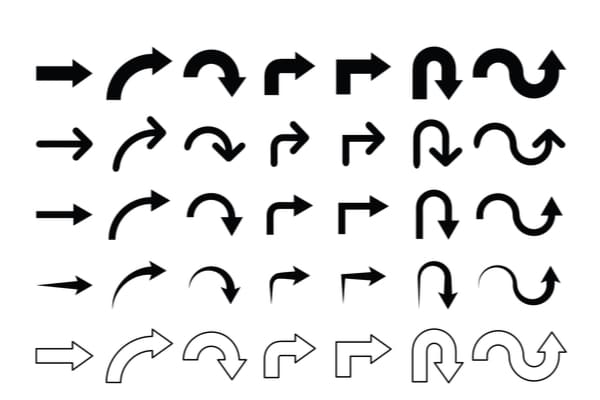If you look closely, arrows are everywhere. They indicate direction, serve aesthetic purposes and have cultural meanings. Arrow symbolism can vary across cultures. This article describes various arrow symbolism across cultures.
To signify direction

Across cultures, arrows are a directional symbol. This means they’re used to show where things are. Used this way, arrows are generally very simple. Since their primary purpose is functional, they’re usually to the point (pun unintended).
The current simplified arrow was developed in the mid-1800s. At that time, the tail ornamentation was removed, keeping the triangular head or diagonal lines converging to a singular point. This brought arrow depictions down to their essential form.
To show movement
English cartographer Emil Reich pioneered using arrow symbolism for analytic and teaching uses. In his book A New Student’s Atlas of English History, he used solid triangular arrows on curving lines to indicate English military campaigns’ movements across Europe.
Today, lines with arrows to represent movement are a common symbology across cultures. Flight paths, weather patterns and more are indicated this way.
See Also: 19 NYC Slang Words with Interesting Meanings
To reflect specific concepts in logos
In some corporate logos, arrow symbolism reflects a specific concept. This can be about the product or service.
For example, the FedEx logo has an arrow hidden inside it. This represents transporting and moving packages and shipments — which is the company’s business.

In the Subway logo, arrow symbolism shows customers going quickly through the sandwich line.

In Native American culture
The arrow is very important in Native American culture. Because hunting and gathering were so important in this culture, arrows had strong symbolic and philosophical meanings.
For Native American peoples, arrows meant life. They were tools for hunting food to feed their families and weapons to protect themselves. Thus, arrows are symbols of both war and peace in Native American culture.
Its depiction and placement change an arrow’s symbolism in Native American culture. A few basic arrow symbolisms are:
- Single horizontal arrow pointing right: protection and defense
- Single horizontal arrow pointing left: warding off evil
- Two horizontal arrows in different directions (left and right): war
- Crossed arrows: friendship
- Single vertical arrow pointing down: peace
- Broken arrow: peace
The five founding tribes of the Iroquois League were also represented by a bundle of five arrows. This symbolized the League’s united strength. While a single arrow is easily broken, a bundle of arrows remains strong.
Some people use Native American arrow symbolism in tattoo designs. If you’re interested in a Native American-inspired tattoo, you might consider a foot tattoo. However, please be sure it’s appropriate to do so.
In Hindu mythology
Rudra, the Hindu god of the winds or storms, is associated with arrows. His weapons include a bow and arrow. Additionally, he is called “the archer.”
As a symbol of love

In Roman mythology, Cupid used arrows to piece the heart with love. So, an arrow through the heart represents love. Today, this is a common Valentine’s Day motif.
During the 19th century, Cupid was often the instigator of love. He used his golden arrow to the heart to inspire love. Interestingly, his other arrow, which was made of lead, inspired hate.
If you’re looking for Valentine’s Day-themed makeup looks, see: Last Minute Valentine’s Day-themed Makeup Products
To symbolize having kids
Used with Cupid, arrows can mean having children. Love birds indicate marriage, and a lit torch indicates life.
As a symbol of war

Arrows were also symbols of war in Roman mythology. Both Apollo (god of the Sun) and Artemis (goddess of wild animals and hunting) used arrows for hunting. While most people don’t use arrows to hunt anymore, arrow symbolism for war persists.
As a symbol of the Zoroastrian god Mithra and the cult of Mithraism
Mithras was a Roman god. He was the god of contracts, a judicial figure, all-seeking protector of Truth, and guardian of cattle, the harvest and the Waters. Roman coins showed him with an arrow.
Mithraism was the worship of Mithras. It was a rival to early Christianity; because of this, Roman Christians. The religion was eliminated by the end of the 4th century.


